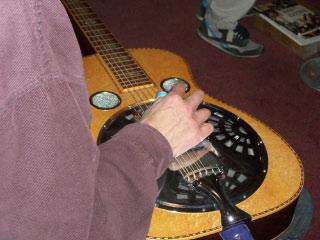Al Hopkins Presentation on Resophonics, 85 Years of History, November 19, 2012

Al Hopkins with Resonator Guitar
Al Hopkins of Golden Link Society captivated Rochester Guitar Club members with his thorough and well organized presentation on Resophonics, taking us through its eighty-five year history as well as the many changes in technology and economics that have occurred up to the present time.

Up Close
It all began in 1908 when the Dopyera brothers immigrated from what later became Czechoslovakia to Los Angeles. They were skilled woodworkers and metal smiths and soon put their talents to work making and repairing fiddles as well as other wooden string instruments while earning patents for improvements on the banjo.
In the 1920’s, vaudeville promoter George Beauchamp approached them looking for a guitar loud enough to be heard over other instruments. They collaborated to combine the technologies of the traditional guitar and the new-fangled radio speaker, experimenting with plastics, cardboard, thin wood and metal, finally settling on aluminum. They proceeded to invent a guitar with three aluminum cones mounted underneath the bridge, creating a mechanical amplifier. Their search for a louder instrument resulted in the formation of two companies, National and Dobro, and the creation of the distinctive American sound of the resonator guitar. This instrument was three to four times louder than a normal acoustic and had a rich, metallic tone.

Check It Out!
The resonator guitar initially sold well, and eventually met with enormous success becoming the staple in jazz clubs and movie houses across the US. Several years later, the brothers separated from the corporation and founded Dobro (the name they also gave to the instrument), their own company, a play on words derived from the “Do” in Dopyera and “bro” from Brothers. The word also means “good” in Slovak, fitting well with their promotional slogan: Dobro means good in any language!
With the onset of the Depression, the National Company began to have financial difficulties and after several years of manufacturing, they decided to move the company to Chicago where they were also able to obtain cowhide for manufacturing banjos. Unlike the earlier tricone design, the Dobro had a single resonator cone and was inverted, with its concave surface facing up. The Dobro Company described this as a bowl shaped resonator. The Dobro was louder than the tricone and cheaper to produce. The cost of manufacturing had, in their opinion, priced the resonator guitar beyond the reach of many players, and the failure to convince fellow directors at the National to produce a single-cone version was part of the motivation for leaving. Eventually this design was also applied to other instruments such as mandolins and ukuleles.

The Petting Zoo!
In the early days, Hawaiian music had been one of the reasons for the popularity of the resonator instruments, but in later years it was their use in bluegrass and country music that kept the interest in resonators alive even after the volume was no longer an issue due to electronic amplification. Today, well made resonator guitars are available in the U.S., but tend to be expensive. Reasonably good instruments at an affordable price are made in China and the Czech Republic.
Al’s fascinating discussion of the history and development of the resonator guitar generated a lively discussion on various aspects of the instrument. He followed this up with his instrumental ’petting zoo’ for anyone interested in trying standard, Hawaiian, or blues slide techniques on vintage and modern Nationals and Dobros. Those of us present responded enthusiastically to this offer trying out a variety of unusual instruments!
~R. Taglieri
Share this page: ![]() Facebook
Facebook
![]() Del.icio.us
Del.icio.us
![]() StumbleUpon
StumbleUpon
![]() Digg
Digg
![]() Reddit
Reddit
Home ::
About Us ::
Events ::
Articles ::
Resources ::
Contact Us ::
Links
©2007-2012, Rochester Guitar Club, All Rights Reserved, This page last updated 2013-11-13 11:04:30
Website by Red Beagle Web Development.








